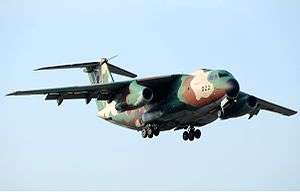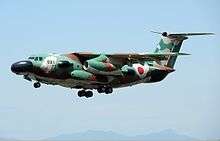Kawasaki C-1
| C-1 | |
|---|---|
 | |
| A JASDF C-1 at Iruma Air Base in 2011 | |
| Role | Military transport aircraft |
| National origin | Japan |
| Manufacturer | Kawasaki Heavy Industries |
| First flight | 12 November 1970[1] |
| Introduction | December 1974 |
| Primary user | Japan Air Self-Defense Force |
| Number built | 31 |
| Unit cost |
¥4.8 billion |
The Kawasaki C-1 (川崎 C-1) is a twin-engined short-range military transport aircraft, used by the Japan Air Self-Defense Force (JASDF). Development began in 1966 as the JASDF sought to replace its aging World War II–era Curtiss C-46 Commandos. Production commenced in 1971, and the aircraft remains in service. It will eventually be replaced by the Kawasaki C-2.
Development
In 1966, the Japan Air Self-Defense Force transport fleet was composed primarily of Curtiss C-46 Commandos, a retired midwar American design built in large numbers before the end of World War II. While relatively capable for its time, the C-46 did not fare well in comparison to newer aircraft such as the Lockheed C-130 Hercules, and the JASDF therefore elected to replace it with a domestically-designed and -manufactured transport aircraft.
For this purpose, they turned to the Nihon Aircraft Manufacturing Corporation, a consortium of several major corporations, which had begun to produce commercially its YS-11 airliner four years earlier. NAMC decided that Kawasaki Heavy Industries was to be the prime contractor, and the airplane thus bears that company's name. The aircraft has been used as military transport for the JASDF since its maiden flight in November 1970.
Japanese policies at the time on military equipment were strict in that they were not to have offensive capabilities, and so the maximum range was cut in order to keep the aircraft's operational range inside Japan. This proved to be a problem after Okinawa was returned to Japan from the US, and the aircraft had trouble reaching the island from distant areas. Thus production was reduced and the C-130H was introduced, entering service with 401st Tactical Airlift Squadron in 1989.[2][3][4][5][6][7]
Operational history
The Kawasaki C-1 has been in use since 1974 but will be replaced by the new Kawasaki C-2, which is larger, can lift three times the weight and has a longer range. The first of twenty C-2s is expected to be delivered in 2014.[8]
On 30 June 2016, 1st production model C-2 aircraft, "68-1203", was delivered to Air Development and Test Wing at Gifu Air Field.[9]
Variants

- XC-1: Prototypes.
- C-1/C-1A: Medium-range military transport version.
- The last five C-1s ordered were fitted with an additional 4,730 litre fuel tank.
- EC-1: electronic warfare training aircraft.
- C-1FTB: Flight test bed used for testing various equipment.

- Asuka/QSTOL: Quiet STOL research aircraft, developed by the National Aerospace Laboratory.
- Powered by four FRJ710 turbofan engines and making use of the Coandă effect. It was built to research STOL using upper surface blowing, aircraft noise reduction, fly-by-wire systems and composite materials construction. The only example built is currently on display in Kakamigahara Aviation Museum in Gifu, Japan.
Note: Three C-1s were allocated to the MSDF as airborne minelayers under the Fourth Defense Buildup Plan (1972–76). It is unknown what designation was given to them, or indeed whether they were ever actually delivered.
Operators
- Japan Air Self-Defense Force
- 402nd Tactical Airlift Squadron (1973–present)
- 403rd Tactical Airlift Squadron (1979–present)
Former operators
Accidents
- 19 April 1983
- Two C-1s of the 401st Tactical Airlift Squadron crashed near Toba, Mie when the lead two airplanes of a formation of 5 en route from Komaki Air Base to Iruma Air Base flew into a hill while flying in low visibility at low altitude. A third airplane narrowly avoided also crashing and struck trees, but was able to return to Komaki Air Base. Fourteen personnel were killed in these two aircraft, six personnel in airplane 68-1015 and eight in aircraft 58-1009.[10][11]
- 18 February 1986
- C-1 58-1010 suffered extensive damage on take off from Iruma Air Base and was declared a write-off, with no injuries to crew.[12]
Specifications (Kawasaki C-1)

Data from [15]
General characteristics
- Crew: 2 flight crew and 3 mission crew
- Capacity: 8,000 kg (18,000 lb) normal payload
- Length: 29 m (95 ft 2 in)
- Wingspan: 30.6 m (100 ft 5 in)
- Height: 9.99 m (32 ft 9 in)
- Wing area: 120.5 m2 (1,297 sq ft)
- Aspect ratio: 7.8
- Empty weight: 23,220 kg (51,191 lb)
- Max takeoff weight: 38,700 kg (85,319 lb)
- Fuel capacity: 15,200 l (4,000 US gal; 3,300 imp gal) in 4 integral tanks in the wings
- Powerplant: 2 × Pratt & Whitney JT8D-M-9 (Mitsubishi built) low bypass turbofans>, 64 kN (14,500 lbf) thrust each
Performance
- Maximum speed: 806 km/h (501 mph; 435 kn) at 7,620 m (25,000 ft) at 35,450 kg (78,150 lb)
- Cruise speed: 657 km/h (408 mph; 355 kn) at 10,670 m (35,010 ft) at 35,450 kg (78,150 lb)
- Range: 3,353 km (2,083 mi; 1,810 nmi) with max fuel & 2,300 kg (5,100 lb) payload
- Service ceiling: 11,580 m (37,990 ft)
- Rate of climb: 17.75 m/s (3,494 ft/min) at sea level
- Wing loading: 321.2 kg/m2 (65.8 lb/sq ft)
- Thrust/weight: 0.003 kN/kg (0.34 lbf/lb)
Notable appearances in media
See also
Aircraft of comparable role, configuration and era
Related lists
References
- ↑ Taylor 1976, p.124.
- ↑ Kawasaki C-1 Tactical Transport Aircraft Military Today Retrieved February 13, 2017
- ↑ Kawasaki C-1 Medium-Lift Transport Aircraft Military Factory Retrieved February 13, 2017
- ↑ C-1 Medium Transport Kawasaki Heavy Industries Retrieved February 13, 2017
- ↑ Kawasaki C-1 The Aviation Zone Retrieved February 13, 2017
- ↑ Kawasaki C-1/QSTOL Airliners.net Retrieved February 13, 2017
- ↑ Japanese Transports Airvectors.netRetrieved February 13, 2017
- ↑ "Japanese AF Calls For Speedy C-2 Deliveries | AVIATION WEEK". 8 August 2011. Retrieved 2011-08-08.
- ↑ "Kawasaki Delivers First Mass-produced C-2 Transport Aircraft to JASDF" Kawasaki Heavy Industries.
- ↑ ASN Aircraft accident Kawasaki C-1 68-1015 Toba Retrieved February 29, 2016
- ↑ ASN Aircraft accident Kawasaki C-1 58-1009 Toba Aviation Safety Network Retrieved January 23, 2017
- ↑ ASN Aircraft accident Kawasaki C-1 58-1010 Iruma Air Base Retrieved February 29, 2016
- ↑ "Japanese Military Plane Crashes". Associated Press. 28 June 2000. Retrieved 24 June 2015 – via HighBeam Research. (Subscription required (help)).
- ↑ ASN Aircraft accident Kawasaki C-1 88-1027 Shimano Aviation Safety Network Retrieved January 23, 2017
- ↑ Taylor, John W.R., ed. (1975). Jane's all the world's aircraft, 1975–76 (66th annual ed.). New York: Franklin Watts Inc. pp. 146–147. ISBN 978-0531032503.
Further reading
- Taylor, John W. R., ed. (1973). Jane's all the World's Aircraft 1976–77. London: Jane's Yearbooks. ISBN 0 3540 0538 3.
External links
| Wikimedia Commons has media related to Kawasaki C-1. |